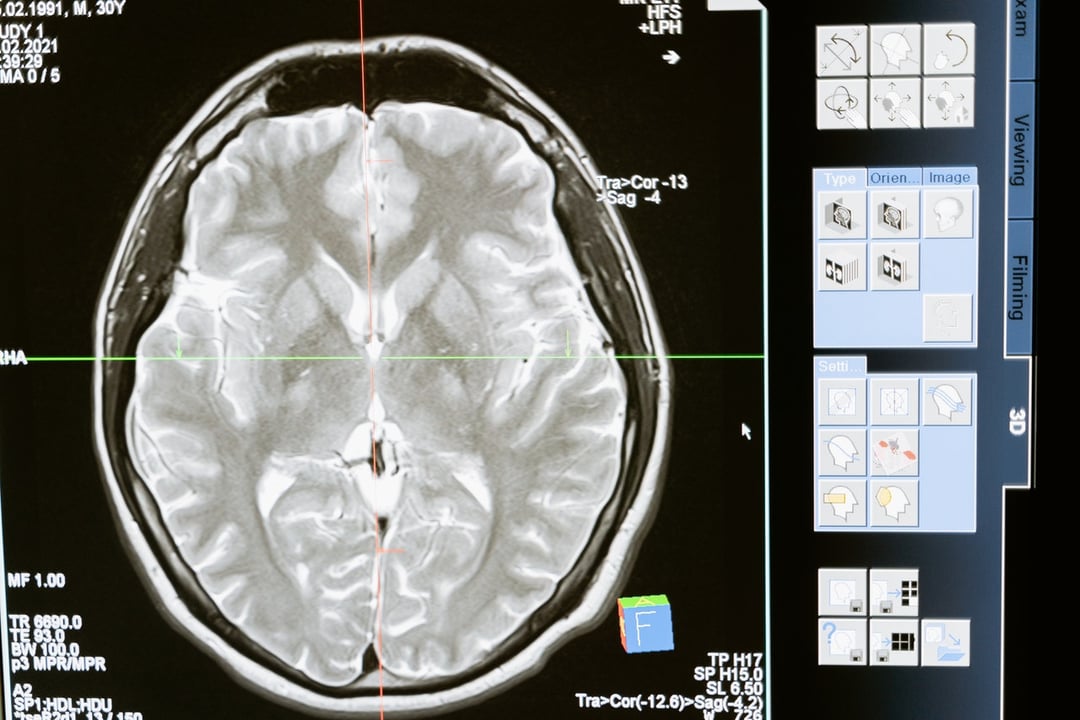The 5-HT2A receptor ("5-HT" = 5-hydroxytryptamine, also known as serotonin) is a widely-expressed Gq-coupled protein receptor (GCPR) that triggers a range of intracellular pathways. In this article, we will explore everything scientists know so far about the location, function, and pharmacology of this unique protein.
5-HT2A receptor location
5-HT2A receptors are expressed in many tissues and organs throughout the body including the brain, gut, and cardiovascular system (CVS). The earliest studies exploring 5-HT2A localization used radioactive ligand binding experiments in rats.1 However, these could not differentiate between 5-HT2 receptor subtypes. It was only when DNA sequencing and subtype-specific antibodies were developed that the location of the 5-HT2A receptor could be fully characterized.1
5-HT2A localization in the CNS
Central nervous system (CNS) expression of the 5-HT2A receptor is most extensive in the cortex, hippocampus, basal ganglia, and forebrain.1 Because these areas of the CNS are primarily involved with cognitive function and social interactions, 5-HT2A is implicated in the pathology of several cognitive and learning disorders1 including schizophrenia,2 obsessive-compulsive disorder (OCD),3 and depression.4 The highest density of 5-HT2A receptors is found in levels 1, 4, and 5a of the cortex, with medial expression levels in the olfactory bulb, brainstem, and dorsal horn of the spinal cord.1 5-HT2A is also expressed by a range of CNS cells, including pyramidal neurons and glia, and has several intracellular locations too.1
5-HT2A localization in the CVS
The CNS contains the highest density of 5-HT2A protein and mRNA1; however, 5-HT2A is also expressed in the CVS by platelets,1 endothelial cells,1 and smooth muscle cells.5 In the CVS, 5-HT2A functions primarily in inflammation and wound healing. For example, when the blood vessel endothelium is damaged, serotonin is released, and vasoconstriction is triggered by the activation of 5-HT2A receptors6 on smooth muscle cells in the resistance vasculature, including coronary arteries.7 Due to its considerable and wide-range expression, 5-HT2A has several molecular functions in humans which we will explore in the next section.
5-HT2A receptor function at the molecular level
In the CNS, the 5-HT2A receptor is thought to be involved in learning, memory, and neurogenesis1 but its role in cognition is still not fully understood. In the CVS, the receptor is activated by 5-HT during wound healing and inflammation to trigger platelet aggregation and vasoconstriction.6 Below, we have summarised the intracellular cascades activated in cells that express this receptor, and the key biochemical signals influenced.
Intracellular cascades activated by 5-HT2A
5-HT2A has several recognition motifs for ligand binding and couples to several intracellular signaling cascades.1 This has made it difficult for scientists to determine the full range of physiological functions it affects and how these can be modulated pharmacologically. To complicate matters further, the 5-HT2A receptor displays functional selectivity which means a range of factors - such as post-translational modifications, ligand type, and intracellular location - determine which pathway is activated.1 Although different ligands can activate differential intracellular pathways, it is important to note that these can result in the same biochemical signal and therefore a similar physiological outcome.1
There are three distinct biochemical signals influenced by the 5-HT2A receptor: IP3/DAG, arachidonic acid (AA), and 2-aracidonyl-glycerol (2AG).1 Several others have been documented in the literature (table 1), but these represent the key molecules. As the receptor is Gq-coupled, its activation typically leads to the accumulation of IP3/DAG, which in turn leads to calcium release from the endoplasmic reticulum and activation of protein kinase C.1
Functional regulation of 5-HT2A
The functional regulation of 5-HT2A involves desensitization and re-sensitization, which differentiates 5-HT2A from conventional GCPRs (e.g. the B2 adrenergic receptor) and prevents overstimulation.1 At the molecular level, desensitization and re-sensitization of the receptor are controlled via clathrin-mediated receptor internalization and recycling.1 This dynamin-dependent internalization can be triggered by antagonists or agonists of the receptor and exists to allow the recuperation of signaling competence.1 Long-term use of 5-HT2A antagonists has been shown to downregulate 5-HT2A expression1 and, while the mechanism of this "paradoxical regulation" is unknown, it is likely due to functional regulation.
| Interacting Protein | Gene | Region of the 5-HT2A Receptor Involved in Interaction |
| Amyloid-b precursor protein intracellular domain associated protein-1a | AIDA-1A | i3 |
| Eukaryotic translation initiation factor 3, subunit 5 e | EIF3S5 | i3 |
| Neurotrophic tyrosine kinase, receptor, type 3 isoform c precursor | NTRK3 | i3 |
| Melanoma associated antigen | MAAT1 | i3 |
| Paraoxonase 2 | PON2 | i3 |
| Microtubule associated protein 1A | MAP-1A | i3 |
| Ribosomal protein S6 kinase 2 | RSK2 | i3 |
| Nucleoside-diphosphate kinase 3 | NME3 | i3 |
| NADH dehydrogenase (ubiquinone) 1 b subcomplex | NDUFB10 | i3 |
| Protein phosphatase 5, catalytic subunit | PPP5C | i3 |
| Glutamine synthase | GLUL | i3 |
| ADP ribosylation factor 1 | Arfl | C-terminus |
| Post-synaptic density protein-95 | PSD-95 | C-terminus (PDZ-binding domain) |
| Antioxidant protein-2 | AOP-2 | C-terminus (PDZ-binding domain) |
| Activin receptor-interacting protein 1 | ARIP-1 | C-terminus (PDZ-binding domain) |
| Synapse-associated protein 97 | SAP97 | C-terminus (PDZ-binding domain) |
| MAGUK p55 subfamily member-3 | MPP-3 | C-terminus (PDZ-binding domain) |
| Channel-interacting PDZ domain protein | CIPP | C-terminus (PDZ-binding domain) |
| Filamin c | Unknown | Unknown |
| Receptor for activated protein kinase C | RACK1 | C-terminus |
| Calmodulin | CAM | i2, C-terminus |
| Arrestin | ARRB2 | i3 |
| Caveolin-1 | CAV-1 | Unknown |
Table 1: A range of biochemical signals are linked to 5-HT2A activation in humans. Adapted from Raote et al. (2007)1
Abnormalities in 5-HT2A function
Abnormalities in 5-HT2A function have been associated with several mental disorders that have complex etiologies.1 These include schizophrenia, OCD, depression, attention deficit hyperactive disorder (ADHD), eating disorders (ED), and autism spectrum disorder (ASD).1-4 These associations have been made based on genetic screening, protein expression, and molecular data.1 For example, PET studies have shown altered 5-HT2A density in people at increased risk of developing an ED, schizophrenia, and in patients with untreated OCD.1 Malfunction of the receptor has also been associated with the development of atherosclerosis6 due to its role in platelet aggregation and vasoconstriction.
5-HT2A and schizophrenia
There is evidence that abnormalities in 5-HT2A play a significant role in the pathology and treatment of schizophrenia,2 a psychological disorder characterized by psychosis. Because the receptor modulates dopamine release in the cortex and striatum,1 changes in 5-HT2A function are thought to be responsible for the motor and cognitive defects observed in the disease. Evidence for 5-HT2A's role in schizophrenia includes post-mortem studies and receptor pharmacology.1 Post-mortem studies have shown differential 5-HT2A expression in the brains of schizophrenics and increased 5-HT2A expression in suicide cases where schizophrenic symptoms were present.1 Pharmacologically, 5-HT2A agonists (i.e. hallucinogens) mimic symptoms of the disease, and most antipsychotics bind to the 5-HT2A receptor. However, genetic studies have found no association between 5-HT2A receptor polymorphisms and schizophrenia so far.1
5-HT2A in OCD, ADHD, and depression
Patients with OCD show increased binding to 5-HT2A receptors in the brain (e.g. caudate nuclei) and genetic studies have shown links between OCD and 5-HT2A polymorphisms.1 In ADHD receptor expression is unaffected, but 5-HT2A polymorphisms may be a modulating factor of the disease.1 Depressed patients have shown decreased levels of 5-HT2A expression in the hippocampus and platelets, but it is unclear if there is a link between 5-HT2A mutations and disease onset or severity. Regardless, long-term use of tricyclic anti-depressants can reduce the density of 5-HT2A receptors in the cortex1 (due to functional regulation of the receptor), and 5-HT2A agonists have recently been found to reduce brain network modularity in patients with severe depression.4
5-HT2A and cardiovascular disease
Due to its peripheral role in platelet aggregation and inflammation, the 5-HT2A receptor has been associated with processes that influence atherosclerosis.6 This is because platelet aggregation can trigger thrombosis and occlude diseased arteries6 which can lead to heart attack or stroke. As it is present in coronary arteries7 and capable of mediating vasoconstriction, 5-HT2A has been linked to coronary artery spasms.8 Increased 5-HT2A expression is also observed in patients who experience coronary thrombosis.6
5-HT (serotonin) receptors / 5-HT in coronary arteries
This model assesses the effect of your test article on coronary artery vasoconstriction via 5-HT (serotonin) receptors in comparison to 5-HT (serotonin).
5-HT (serotonin) receptors / Sumatriptan in coronary arteries
This model assesses the effect of your test article on coronary artery vasoconstriction via 5-HT (serotonin) receptors in comparison to sumatriptan.
5-HT (serotonin) receptors / Denuded coronary arteries
This model assesses the effect of your test article on vasoconstriction of denuded arteries via 5-HT (serotonin) receptors in comparison to 5-HT.
What happens when 5-HT2a receptors are blocked?
5-HT2A antagonists block 5-HT2A receptor activity and are primarily used for the treatment of psychosis. However, they can also be used to treat migraine,9 ischemic heart disease,7 and spinal cord injury.10 Examples of commonly prescribed 5-HT2A antagonists include ritanserin,2 methylergonovine,9 clozapine,11 and ketanserin.1 Due to their anti-platelet action 5-HT2A antagonists could be used to prevent cardiovascular disease.6 However, no therapeutics have been trialed so far.
Most antipsychotics are 5-HT2/D2 antagonists
Many antipsychotics antagonize both dopamine and 5-HT2 receptors, which share common anatomical locations and interactions.12 However, not all antipsychotics have equal affinity for these receptors and can be classified depending on their D2/5-HT2 affinity ratio.12 The difference in mechanism between typical and atypical antipsychotics is not yet fully understood; in general, atypical antipsychotics express a high affinity for 5-HT2A receptors12 and preferentially bind to 5-HT2 over D2.13 This increased affinity for 5-HT2 receptors is thought to enhance the effect of D2 antagonists, making them therapeutically effective at lower doses, and meaning that patients experience fewer side effects.13
Side-effects of 5-HT2A antagonists
Due to the widespread expression and functions of the 5-HT2A receptor, antagonism can produce a range of side effects. For example, methysergide commonly causes drowsiness, gastrointestinal disturbance, and leg aches,14 plus idiosyncratic fibrosis in rare cases. Ketanserin has been associated with fatigue in 11% of patients,15 while cyproheptadine can cause weight gain and drowsiness.14 For a while, ritanserin was the exception to this rule15; however, it has since been withdrawn from clinical use due to safety concerns.
This video explains the different mechanisms of the most commonly prescribed antipsychotics.
Clinical and research applications of 5-HT2A agonists
Agonists of the 5-HT2A receptor are thought to have significant potential in the treatment of major depression,4 substance abuse,16 and existential anxiety.3 However, most 5-HT2A agonists are hallucinogenic (with the exception of SR46349B)1 meaning research into their therapeutic use has been limited. Such hallucinogenics may have therapeutic potential and there is a case for determining their neuro-physical effects.16
Despite the wide variety of hallucinogens available, they all share the same phenomenology, producing "mystical states" and schizophrenic-like symptoms in users.3 These 5-HT2A agonists activate the 5-HT2A receptors on cortical pyramidal neurons,16 disrupting the cortico-striato-thalamo-cortico (CSTC) circuits.17 The result is disrupted thalamic filtering and increased cortical excitability which is thought to cause hallucinations.17 In the following section, we will explore the clinical evidence for the therapeutic use of hallucinogenics and how they have contributed to what we know about the 5-HT2A receptor so far.
Lysergic acid diethylamide and early 5-HT2A research
Historical experiments using lysergic acid diethylamide (LSD) have contributed greatly to what we now know about the function and pathology of the 5-HT2A receptor. Studies using LSD helped to characterize the function of 5-HT2A and its role in schizophrenia.1-2 When researchers found that the hallucinogenic effects of LSD did not correlate with the typical IP3/DAG pathway, they shortly discovered that the receptor was functionally selective and was linked to multiple intracellular pathways.1 In schizophrenia, abnormalities in sensory gating and deficits in spatial working memory, and psychiatric symptoms are similar to the effects of LSD, implicating the 5-HT2A receptor in this disease.2
Psilocybin and major depression
Increased network modularity is a symptom of major depression that is directly correlated with symptom severity.4 A recent Nature study exploring the effects of this drug in patients with major depression found that treatment with psilocybin caused a significant increase in global network integration.4 Results were observed just one day after oral administration of psilocybin and were not observed in the control group treated with the selective serotonin reuptake inhibitor (SSRI) escitalopram. The researchers noticed that psilocybin dysregulated activity and caused functional changes in areas of the brain with high 5-HT2A density,4 supporting the hypothesis that psilocybin is a selective 5-TH2A agonist. On the other hand, SSRIs did not affect network modularity.4
While the sample size of this study was small, the results were significant. It represents one of the few clinical trials using 5-HT2A agonists and could help treat severely depressed individuals where other therapeutics have failed.4 The authors concluded that the liberating effect on cortical activity induced by psilocybin could lead to a long-term reduction in network modularity and improvements in depression severity4 but that further clinical studies were needed to explore its full therapeutic potential.
5-HT2A and cardiovascular safety
As serotonin triggers platelet aggregation via the 5-HT2A receptor,5 pharmacologists are often concerned about the cardiovascular effects of 5-HT2A antagonists and agonists. As a result, drugs targeting 5-HT2A (directly or indirectly) are usually subject to cardiovascular safety pharmacology studies.
However, the link between drugs targeting this receptor and CVD is not clear. For example, there is increased cardiovascular co-morbidity in patients with schizophrenia, but this correlation is also present in unmedicated patients.18 And while some SSRIs19 and 5-HT2A agonists can affect blood pressure, serious cardiac events are rare.18 The cardiovascular effects of 5-HT2A therapeutics are more apparent in animal studies.19 However, there are significant species differences, which we will discuss in the next section.
Species differences in 5-HT2A expression and function
Not only is the 5-HT2A receptor functionally selective, but in vivo behavior can also vary between human and animal models. The most pronounced species differences are observed in rats, which are commonly used to model neuropsychiatric drugs. In rats, differences in the amino acid sequence of the fifth transmembrane domain5 result in significant functional differences. At this point in the sequence, Ser242 is swapped for Ala242, which has been shown to change binding affinity and functional potency.5 In one study this led to significant cardiovascular safety issues in rats that were not observed in other species.5
To complicate matters even further, internalization of the 5-HT2A receptor is β-arrestin-independent in rats, rather than clathrin-mediated, and 5-HT2A receptor function can vary depending on the animal behavior being modeled.1,20 For example, it is difficult to demonstrate or prove that rats experience hallucinations using current behavioral paradigms.16 And the behavior of 5-HT2A knock-out (KO) mice contradicts those observed in humans.18 These species' differences could lead to completely different drug potencies and efficacies in rodents compared with humans,1 so it is important to generate data in translational human models where possible.
Exploring species differences ex vivo
If you are concerned about the off-target effects of your test articles on 5-HT receptors, we offer a range of human assays exploring 5-HT interactions in addition to species comparison models. Our ex vivo studies are useful for troubleshooting unexpected clinical side effects and have even saved compounds from clinical failure. Case studies investigating the effects of 5-HT on cardiovascular tissues are listed below:
- Human tissue testing rescued Pharma's drug from clinical failure
- Vasoconstriction in human saphenous vein (5-HT receptor)
- Contractile force in electrically stimulated human ventricular trabeculae muscle (5-HT receptor)
- Contractile force in electrically stimulated human atrial pectinate muscle (5-HT receptor)
- Vasoconstriction in human subcutaneous resistance arteries (5-HT receptor)
References
- Raote I et al. Serotonin 2A (5-HT2A) Receptor Function: Ligand-Dependant Mechanisms and Pathways. Serotonin Receptors in Neurobiology (2007).
- Jones D et al. Developing New Drugs for Schizophrenia: From Animals to the Clinic. Animal and Translational Models for CNS Drug Discovery pp 199-261 (2008).
- Halberstadt AL et al. Neuropharmacology of Lysergic Acid Diethylamide (LSD) and Other Hallucinogens. Biological Research on Addiction 2 pp 625-635 (2013).
- Daws RE et al. Increased global integration in the brain after psilocybin therapy for depression. Nature Medicine (2022).
- Miller KJ et al. Position 5.46 of the serotonin 5-HT2A receptor contributes to a species-dependent variation for the 5-HT2C agonist (R)-9-ethyl-1,3,4,10b-tetrahydro-7-trifluoromethylpyrazino[2,1-a]isoindol-6(2H)-one: impact on selectivity and toxicological evaluation. Molecular Pharmacology 76 pp 1211-1219 (2009).
- Marcinkowska et al. Exploring the antiplatelet activity of serotonin 5-HT2A receptor antagonists bearing 6-fluorobenzo[d]isoxazol-3-yl)propyl) motif– as potential therapeutic agents in the prevention of cardiovascular diseases. Biomedicine & Pharmacotherapy 145 (2022).
- Nagatomo et al. Functions of 5-HT2A receptor and its antagonists in the cardiovascular system. Pharmacology & Therapeutics 104:1 pp 59-81 (2004).
- Nilsson T et al. Characterization of 5-HT receptors in human coronary arteries by molecular and pharmacological techniques. European Journal of Pharmacology 7:372 pp 49-56 (1999).
- Culebras A. Other Neurological Disorders. Principles and Practice of Sleep Medicine (2005).
- Cote MP. Role of chloride cotransporters in the development of spasticity and neuropathic pain after spinal cord injury. Neuronal Chloride Transporters in Health and Disease pp 463-516 (2020).
- Coward DM. The pharmacology of Clozapine-like, atypical antipsychotics. Antipsychotic Drugs and their Side-effects pp 27-44 (1993).
- Schaus JM et al. Dopaminergic Approaches to Antipsychotic Agents. Annual Reports in Medicinal Chemistry (1998).
- Fuxe K et al. Dopamine. Progress in Brain Research 211 pp 2-301 (2014).
- Tepper SJ. Headache. Handbook of Clinical Neurology 97 pp 2-825 (2010).
- Schweitzer PK. Drugs that Disturb Sleep and Wakefulness. Principles and Practice of Sleep Medicine pp 542-560 (2005).
- Hanks JB et al. Hallucinogens. Neuropathy of Drug Addictions and Substance Misuse 2 (2016).
- Tyls et al. Neurobiology of the Effects of Psilocybin in Relation to Its Potential Therapeutic Targets. Neuropathy of Drug Addictions and Substance Misuse 2 pp 782-793 (2016).
- Nicholas CD. Serotonin 5-HT2A Receptor Function as a Contributing Factor to Both Neuropsychiatric and Cardiovascular Disease. Cardiovascular Psychiatry and Neurology (2009).
- Behlke LM et al. The Cardiovascular Effects of Newer Antidepressants in Older Adults and Those With or At High Risk for Cardiovascular Diseases. CNS Drugs 34 pp 1133-1147 (2020).
- Aloyo VJ et al. Membrane proteins as drug targets. Progress in Molecular Biology and Translational Science pp 1-247 (2010).







